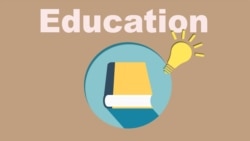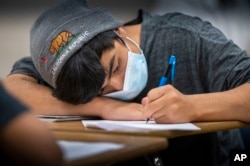New research shows American students made academic progress this past school year compared to a year earlier.
During the 2020 to 2021 school year, COVID-19 restrictions were still in effect in many places in the United States.
Student gains in reading and math were larger than the previous school year and similar to student development before the COVID-19 pandemic.
The research comes from NWEA, or the Northwest Evaluation Association, a nonprofit educational research group that issues standardized tests.
The NWEA said the gains were observed across income levels. The progress partly made up for lost learning and lack of teaching that resulted from the pandemic, researchers found. However, students in poor schools fell further behind. It is likely they will need more time than higher-income students to make a full recovery.
The study suggested that a full academic recovery will likely continue longer than federal COVID-19 aid money remains available. If recovery happens at the same speed it did in the 2021 to 2022 school year, a full recovery would go beyond the 2024 limit for schools to spend their federal aid, the study said.
The test results are a sign of hope for academic recovery from COVID-19. But continued effort and spending on education remains very important. It could be difficult to see continued improvements with such a long recovery, said Karyn Lewis. She is the director of the Center for School and Student Progress at NWEA. She helped write the study.
The study used data from more than 8 million students. The students had taken the MAP Growth test in reading and math during the three school years of COVID-19 restrictions. Their results were then compared with data from three years before the pandemic.
Lewis said in a statement that the improvements “are especially heartening during another challenging school year of more variants, staff shortages,” and other problems.
For the average elementary school student, researchers predicted that it would take three years to return to pre-pandemic performance levels. For older students, recovery could take much longer. The amount of time could be different depending on the grade level and social details of students. But researchers found most students will need more than the two years where increased federal aid money is available.
Lewis told the publication Education Week: “Once the federal recovery funds are gone [in 2024], I’m seeing just continuing gaps widening…”
She said differences, or gaps, would be especially large for what she called “historically marginalized student groups” who struggled during the pandemic.
Lindsay Dworkin is the vice president of policy and communications at NWEA. She said the most successful way to improve student success was increased instructional time. That included more class time, more one-on-one instruction, or high-quality summer classes. But those measures can be costly and complex. School systems may be unwilling to spend the money on them when aid money must be used very soon.
“The funding expires in such a short amount of time that districts are really struggling with, ‘What can I do that will be big and impactful and I only need to do for two years?’” Dworkin told The Associated Press. “I think if they knew that there would be more federal money coming and that it would be sustained, that would make all the difference..."
The NWEA studied national data for its report. But Dworkin said understanding each local school system was necessary to understanding how to best support schoolchildren. In addition to differences across student groups, districts that share similar qualities, like race and poverty levels, still showed large differences in student results.
“If you are a district leader, there’s just no national story that is going to tell you enough about your district context, without the hard work of digging into the data and understanding what it says," Dworkin said.
I’m Dan Novak.
Dan Novak adapted this story for VOA Learning English based on reporting by The Associated Press and additional information from Education Week.
_____________________________________________________________
Words in This Story
academic — adj. relating to schools and education
standardized test –n. a test given equally to all students aimed at measuring their learning
gap –n. a difference between people or groups
heartening — adj. to cause someone to feel better
challenging –adj. difficult
variant — n. a version of something that is a little different from similar versions
marginalized –adj. kept in a powerless or unimportant position within a society or group
expire — v. to end, to no longer be in effect
sustain –v. to provide what is needed for something to continue
context –n.
______________________________________________________________
We want to hear from you. We have a new comment system. Here is how it works:
- Write your comment in the box.
- Under the box, you can see four images for social media accounts. They are for Disqus, Facebook, Twitter and Google.
- Click on one image and a box appears. Enter the login for your social media account. Or you may create one on the Disqus system. It is a blue circle with “D” on it. It is free.
Each time you return to comment on the Learning English site, you can use your account and see your comments and replies to them. Our comment policy is here.












Forum